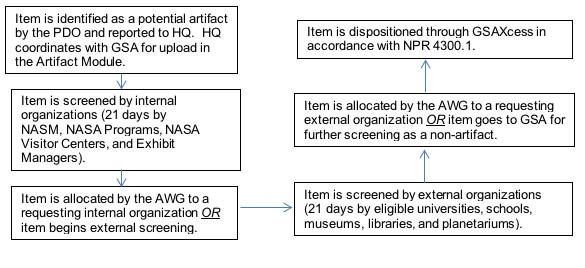
Procedural
Requirements
Effective Date: May 12, 2014
Expiration Date: May 12, 2025

|
NASA Procedural Requirements |
NPR 4310.1A Effective Date: May 12, 2014 Expiration Date: May 12, 2025 |
| | TOC | Preface | Chapter1 | Chapter2 | Chapter3 | AppendixA | AppendixB | AppendixC | ALL | |
3.1 Artifact Screening Process. The artifact screening process begins when an item loses its technical utility, is no longer needed by a NASA program or activity, and is considered excess by the owning organization. POs shall work closely with their Center Historians, PAOs, Exhibit Managers, HPOs, SEMOs, and the Center PDO to ensure potential artifacts are identified and appropriately turned in to the PDO. Throughout the process, PDOs safeguard, account for, transfer, and report artifacts in accordance with Federal, NASA, and Center disposal policies and procedures (illustrated at Figure 3-1).

Figure 3.1 Artifact Process
3.1.1 The PDO shall execute transfers of artifacts in compliance with all Federal property regulations, including 41 CFR pt. 102-36.
3.1.2 Turn-in documents will clearly indicate that the property is to be processed as an artifact and contain a description of the item's relationship to a program or project, system, subsystem, prototype, test unit, or facility. Items that are known to have "flown" should be identified as "flown." If feasible, the property will be accompanied by other identifying documents, such as operating handbooks, summary reports, drawings, logbooks, photographs, videotapes, motion picture film, audiotapes, and historically significant telemetry and test data. If possible, a recent photograph of the property should accompany the turn-in document or be provided soon thereafter.
Note: It may be inappropriate to include official records as artifacts or provide them as accompanying documentation with artifacts; however, copies of these records may be included if appropriately marked as non-record copies. Artifact screening will comply with NASA Records Management contained in NPR 1440.6.
3.2 Artifact Screening Module. NASA uses a Web-based "Artifact Module" that is hosted and maintained by GSA as a primary aid to screen personal property that is or has the potential to be an artifact. The Artifact Module provides a way for eligible organizations to screen, request, and receive NASA property that are deemed to be artifacts. The Artifact Module is managed and controlled by the AWG.
3.3 Artifact Allocation.
3.3.1 The AWG shall provide oversight for artifact identification, screening, and allocation.
3.3.2 The AWG shall make routine, day-to-day artifact allocation decisions.
3.4 Eligibility to Receive Artifacts. Eligible recipients include:
3.4.1 NASM. NASA Exhibit Managers may request artifacts either for their exhibits in support of the Agency's outreach mission or on behalf of their respective NASA Visitor Center. Artifacts for display at NASA Visitor Centers are generally on loan from an exhibit manager and under the accountability of NPR 4200.1, NASA Equipment Management Procedural Requirements.
3.4.2 Federal Agencies. In some cases, a museum is owned and operated under the management of a Federal agency (e.g., a military museum) and is eligible to request and receive NASA artifacts for display.
3.4.3 Schools, universities, and other educational organizations are eligible, but must be registered as a member of the Department of Education's (DOE's) Integrated Postsecondary Education Data System (IPEDS) or DOE's National Center for Education Statistics (NCES).
3.4.4 Museums, libraries, and planetariums are eligible but first shall be determined eligible to receive Federal surplus property by their respective State Agency for Surplus Property (SASP).
3.4.5 A person is allowed to take possession of an artifact on behalf of any eligible organization only if they are a United States citizen, specifically defined as:
a. Born in the United States, Puerto Rico, Guam, Northern Mariana Islands, Virgin Islands, American Samoa, or Swain's Island; or
b. Born to a United States citizen residing in a foreign country; or
c. Granted citizenship status by the U.S. Citizen and Immigration Services (USCIS).
3.5 AWG Allocation Arbitration. When a decision by the AWG is challenged, the following arbitration process is followed:
3.5.1 First, the AWG shall reconvene and review its allocation decision and provide a formal response to the organization challenging the AWG's allocation decision.
3.5.2 A NASA Center may then elevate their challenge to the CCC for its consideration/determination.
3.5.3 The NASM may elevate their challenge to the JAC as addressed in Appendix C.
3.6 Restrictions, Exemptions, and Exceptions on Items Offered as Artifacts.
3.6.1 Artifact identification, management, and disposition actions will not interfere with NASA's ability to execute its various missions and programs.
3.6.2 The property will no longer be needed for its intended purpose or needed for other programmatic use within NASA. Programmatic reutilization always takes priority over property allocation as an artifact.
3.6.3 Property provided for artifact screening may be categorized as restricted property under Export Administration (EAR) or International Traffic in Arms (ITAR) regulations; however, transfer will be done only after a recipient agrees to conditional transfer restrictions.
3.6.4 The property will not present unacceptable danger/hazard to the recipient.
3.6.5 Should the item require a material Safety Data Sheet (SDS), the SDS will be appropriately documented.
3.6.6 Aircraft and aircraft parts will be carefully handled to prevent inadvertent reintroduction of obsolete, worn out, or unsafe parts into the worldwide inventory. Limitations/restrictions and requirements for mutilation of aircraft parts are documented in 41 CFR 102.33, Management of Government Aircraft.
| TOC | Preface | Chapter1 | Chapter2 | Chapter3 | AppendixA | AppendixB | AppendixC | ALL | |
| | NODIS Library | Property, Supply and Equipment(4000s) | Search | |
This document does not bind the public, except as authorized by law or as incorporated into a contract. This document is uncontrolled when printed. Check the NASA Online Directives Information System (NODIS) Library to verify that this is the correct version before use: https://nodis3.gsfc.nasa.gov.